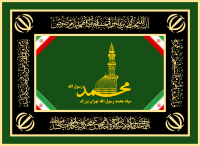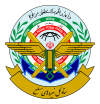| Thar-Allah Headquarters | |
|---|---|
| Persian: قرارگاه ثارالله, romanized: Qarārgāh-e Ṣārollāh | |
| Active | 1995 - present |
| Country | |
| Branch | |
| Role | Internal security |
| Part of | Islamic Revolutionary Guard Corps |
| Garrison/HQ | Tehran |
| Engagements | Iran student protests, July 1999 2009 Iranian presidential election protests |
| Commanders | |
| Deputy Commander | Hossein Nejat |
| Supreme Leader's Representative | Ali Shirazi |
| Notable commanders | Mohammad Ali Jafari |
The Thar-Allah Headquarters (Persian: قرارگاه ثارالله, romanized: Qarārgāh-e Ṣārollāh, also spelled as Tharallah or Tharollah Headquarters) is an Islamic Revolutionary Guard Corps command. It is in charge of security for Tehran area,[1] although it also carries responsibility for territorial security in the region.[2] The Thar-Allah Headquarters is directly subordinate to the Commander of the Islamic Revolutionary Guard Corps, but its day-to-day operations are supervised by an executive commander.
Due to its powerful position in the national security establishment --defending the national leadership of Iran and securing the national capital-- commanders of the Thar-Allah Headquarters have been criticised for "illegally interfering" in the political process over the years.[3]
Name
"Thar-Allah" roughly translates to “Allah will revenge (Hussein’s blood)”, which refers to Imam Husayn ibn Ali, who was killed in the Battle of Karbala in 680 AD/61 AH.[4]
History
During the first decade after the establishment of the Islamic Republic of Iran in 1979, no dedicated or specialized riot-control forces were available.[5]: 2 In the early 1990s, there were widespread protests that, although being economically-driven and not of a political nature in and of themselves, were dealt with a military (combat-level) response by troops drawn from other parts of Iran.[5]: 3
In recognition of this lack of specialized anti-riot forces, the Ashura and al-Zahra battalions (both consisting of Basij veterans) were established in the 1990s, alongside specific NAJA units.[5]: 3 The Thar-Allah Headquarters was established in 1995 by the order of Iran's Supreme National Security Council, to be headed by the chief commander of the IRGC.[4][5]: 4
The Thar-Allah Headquarters was heavily involved in the suppression of the July 1999 Iranian student protests by order of the Supreme National Security Council. In the aftermath of the protests, Thar-Allah gained full independence as a command centre and was responsible for cracking down on street revolts in 2003.[4]
The Thar-Allah Headquarters also played a major role in the suppression of the 2009 Iranian presidential election protests.[5]: 7 While combat units from the IRGC's Ground Forces were not mobilized, organizations and forces coordinated by the Thar-Allah Headquarters detained, interrogated and allegedly tortured many protestors in Thar-Allah's own facilities and detainment centers as well as in Evin Prison in Tehran.[4]
Mission
The Thar-Allah Headquarters is tasked with the safety and security of the capital city of Tehran, as well as Tehran and Alborz provinces.[6] In particular, it is tasked with protecting key institutions and the offices of the Government of Iran. The Thar-Allah Headquarters is also tasked with thwarting all threats against Tehran.[7] This mandate is reflected in two directions: security-oriented operations, and societally-oriented operations.
Security-oriented operations
Security-oriented operations are the core tasks entrusted to the Thar-Allah Headquarters. These missions include dealing with serious unrest as well as providing security for special events, such as presidential inaugurations and other occasions.[8] The Thar-Allah Headquarters has a number of operational units at both the national level (such as the Imam Ali riot battalions and the Imam Hussein infantry battalions, which are both operationally deployable by relevant territorial commands but trained and equipped by the central government) and regional/local units such as the Beit al-Muqaddas battalions, the Ashura battalions, the Al-Zahra battalions, and the Saheb-al-Zaman Special Unit.[4][9]
The Thar-Allah Headquarters receives intelligence from the Ministry of Intelligence, the Iranian Security Police, and the Intelligence Organization of the Islamic Revolutionary Guard Corps itself.[10]
Society-oriented operations
The Thar-Allah Headquarters is also responsible for operations and tasks related to the civil society. Some of these tasks consist in monitoring and, if necessary, intervening in sociocultural and social-media activities in Tehran, in what is characterized generally as cultural engineering (part of Thar-Allah's mission is to track down regime opponents in cyberspace and arrest them). In recent years, Thar-Allah cyber units have arrested several dissidents, journalists, and fashion and music influencers.[1][9][11]
Society-oriented tasks also include the carrying out of relief and public aid operations.[9] With the outbreak of COVID-19 pandemic in Iran, the Thar-Allah Headquarters have officially been tasked with supporting the relevant medical efforts in Tehran.[12]
Procedures
Under normal circumstances, security provision in and around Tehran rests with the NAJA and the Ministry of Intelligence.[1] When the situation escalates, the Supreme National Security Council can request permission of the Supreme Leader of Iran to deploy the Thar-Allah Headquarters' forces.[1] The Ministry of Intelligence, the NAJA, and all government ministries would then come under its operational control. The Thar-Allah Headquarters, in times of crisis, therefore acts effectively as military governor of Tehran.[13]
Organization

As explained above, the Thar-Allah Headquarters acts as military governor authority of Tehran and thus has significant combat power and influence. It consists of two sub-headquarters, Nasser-e and Quds-e, which serve the northwest and south/southeast of Tehran, respectively.[5]: 3 There are also several other security units composed of IRGC and Basij personnel.[5]: 8
The leadership of the Thar-Allah consists of its Commander (which always is the Commander-in-Chief of the IRGC), its Deputy Commander (in command of day-to-day operations), the Supreme Leader's Representative, the Deputy Coordinator, and a Deputy Operations Commander (usually a brigadier general).[14] Until March 2020, the latter position was held by Nasser Shabani.
Thar-Allah also has a medical unit, which has been headed by Ali Khalili --who was targeted by EU sanctions-- since 2011.[15]
Thar-Allah directly controls three Provincial commands:[13]
- Alborz province: Sepah-e Imam Hassan Mojtaba
- Tehran province: Sepah-e Sayyed al-Shohada
- Tehran city: Sepah-e Muhammad Rasoul Allah
According to the People's Mujahedin of Iran-dominated National Council of Resistance of Iran, Thar-Allah directly controls four subordinate bases in different regions of Tehran:[16]: 39–40
- Qods: Northwest Tehran
- Nasr: Northeast Tehran
- Qadr: Southeast Tehran
- Fath: Southwest Tehran.
Operational units
The Thar-Allah Headquarters is responsible for coordinating the activities of both operational and territorial units. In this respect, the Thar-Allah Headquarters may be compared to a corps-level command.[2] Its most important operational units are the 10th Operational Division Seyyed ol Shohada of Karaj, Alborz province, and the 27th Operational Division Mohammad Rasoul Allah in Tehran. In addition to these operational divisional units there are three brigade-level units:[2]
- Al Mohammad Security Brigade (Tehran city, Tehran province);
- 1st Hazrat-e Zahra Brigade (Tehran city, Tehran province);
- 20th Ramezan Independent Armored Brigade (Hassanabad, Tehran province).
Commanders
Officially, the Commander of the Islamic Revolutionary Guards Corps also retains the direct command of the Thar-Allah Headquarters. The Headquarters, however, has a deputy commander in charge of day-to-day operations. Since the establishment of the Headquarters, the executive command has been held by six individuals:
| No. | Commander | Term | |||
|---|---|---|---|---|---|
| Portrait | Name | Took office | Left office | ||
| 1 | Brigadier general Hossein Nejat | 1997 | 2000[17] | ||
| 2 | Brigadier general Mohammad Ali Jafari (born 1957) | 2000 | 2005[18] | ||
| 3 | Brigadier general Nasser Shabani (born 1957) | 2005 | 13 July 2008[19] | ||
| 4 | Brigadier general Mohammad Hejazi (born 1956) | 13 July 2008[19] | 2010 | ||
| 5 | Brigadier general Mohsen Kazemi | 2010 | 1 July 2017[20] | ||
| 6 | Brigadier general Esmaeil Kousari (born 1955) | 2 July 2017[20][21] | 21 June 2020 | ||
| 7 | Brigadier general Hossein Nejat | 21 June 2020 | incumbent[22] | ||
See also
References
- ^ a b c d Nadimi, Farzin (21 August 2017). "Murmurs of a Second Cultural Revolution". The Washington Institute. Retrieved 22 September 2021.
- ^ a b c Donovan, Marie; Carl, Nicholas; Kagan, Frederick W. (January 2020). "Iran's Reserve of Last Resort" (PDF). www.criticalthreats.org. Critical Threats. pp. 5, 6. Retrieved 19 September 2021.
- ^ "اعلام جرم هفت فعال اصلاحطلب علیه فرماندهان قرارگاه ثارالله سپاه". رادیو فردا (in Persian). Radio Farda. 8 August 2010. Retrieved 13 November 2021.
- ^ a b c d e "The IRGC Headquarters". IranWire. 10 April 2019. Retrieved 9 October 2021.
- ^ a b c d e f g Golkar, Saeid (October 2020). Protests and Regime Suppression in Post-Revolutionary Iran. Washington, USA: THE WASHINGTON INSTITUTE FOR NEAR EAST POLICY. pp. 2, 3, 4, 7, 8. Retrieved 10 October 2021.
- ^ "قرارگاه ثارالله (ع) و امنیت تهران". defapress.ir. 1 July 2016. Retrieved 13 November 2021.
- ^ "Trusted IRGC General Appointed Commander Of Key Base In Iran's capital". RFE/RL. 21 June 2020. Retrieved 21 September 2021.
- ^ "قرارگاه ثارالله وضعیت جدید امنیتی برای تهران تعیین کرد". BBC News فارسی (in Persian). 25 October 2017. Retrieved 13 November 2021.
- ^ a b c Golkar, Saeid (2020). TAKING BACK THE NEIGHBORHOOD The IRGC Provincial Guard's Mission to Re-Islamize Iran. WINEP. pp. 4, 6, 7, 9.
- ^ Aryan, Hossein (26 April 2010). "Iran's Green Movement In The Doldrums?". RadioFreeEurope/RadioLiberty. Retrieved 12 November 2021.
- ^ Vaisibiame, Morad (28 March 2020). "Regional Headquarters Of The IRGC: Tasked With Asymmetrical Warfare; Crushing Dissent". Radio Farda. Retrieved 13 September 2021.
- ^ "Iran official seeks lockdown extension as virus rages - Al-Monitor: The Pulse of the Middle East". Al Monitor. 8 October 2020. Retrieved 20 October 2021.
- ^ a b Sadat Khansari, Mohammad (22 June 2020). "IRGC Appoints Hossain Nejat as Commander of Sarrallah Base: Sign of Regime's Utter Fear of Iran Protests". www.ncr-iran.org. National Council of Resistance of Iran. Retrieved 9 October 2021.
- ^ "تشکیل بسیج مردمی در عراق و سوریه معادلات را برهم زد- اخبار فرهنگی تسنیم | Tasnim". خبرگزاری تسنیم | Tasnim (in Persian). 30 November 2016. Retrieved 20 October 2021.
- ^ "Council Decision 2011/235/CFSP of 12 April 2011 concerning restrictive measures directed against certain persons and entities in view of the situation in Iran". eur-lex.europa.eu. 13 April 2021. Retrieved 20 October 2021.
- ^ Uprising shakes Iran Regime's foundations (PDF). Washington, DC: National Council of Resistance of Iran – U.S. Representative Office. pp. 39–40. ISBN 1-944942-37-8. Retrieved 22 October 2021.
- ^ Rauschenbach, Kyra (21 January 2021). "Supreme leader's son prepares for his political future". www.criticalthreats.org. Critical Threats. Retrieved 10 October 2021.
- ^ "Mohammad Ali Jafari". www.irdiplomacy.ir. Iranian Diplomacy. 13 November 2012. Retrieved 10 October 2021.
- ^ a b "انتصاب سه فرمانده جدید سپاه پاسداران". رادیو فردا (in Persian). Radio Farda. 13 July 2008. Retrieved 13 November 2021.
- ^ a b Karami, Arash (6 July 2017). "IRGC makes changes in Tehran after Islamic State attacks - Al-Monitor: The Pulse of the Middle East". www.al-monitor.com. Retrieved 10 October 2021.
- ^ "Esmail Kosari takes over security role in IRGC". Tehran Times. 2 July 2017. Retrieved 10 October 2021.
- ^ Vaisibiame, Morad (21 June 2020). "A New Appointment At IRGC May Signal Concern Over Unrest In Iran". RFE/RL. Retrieved 9 October 2021.








